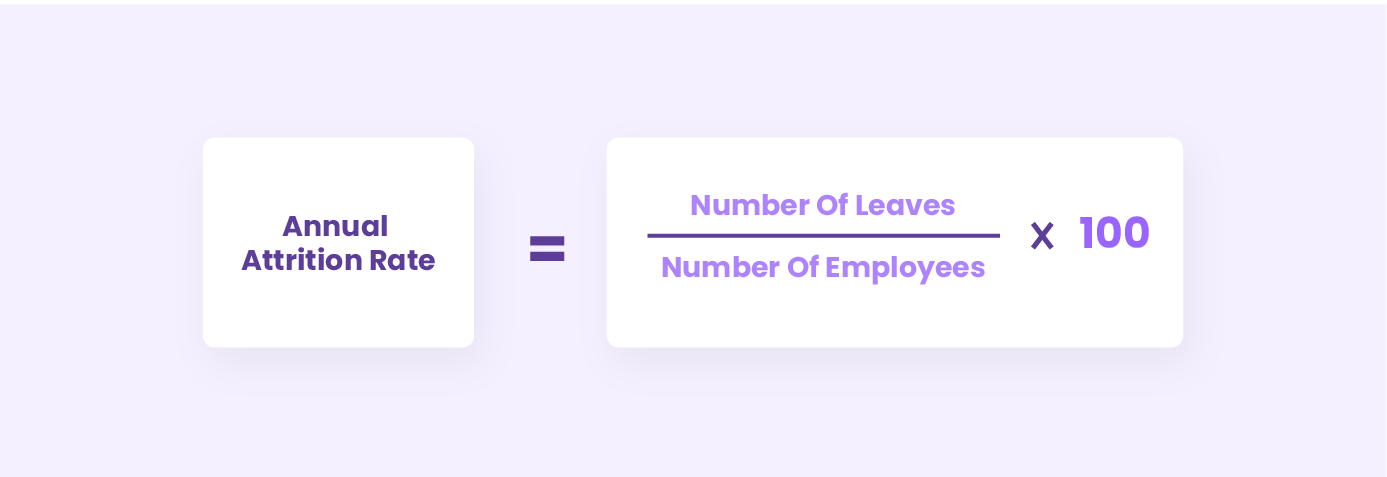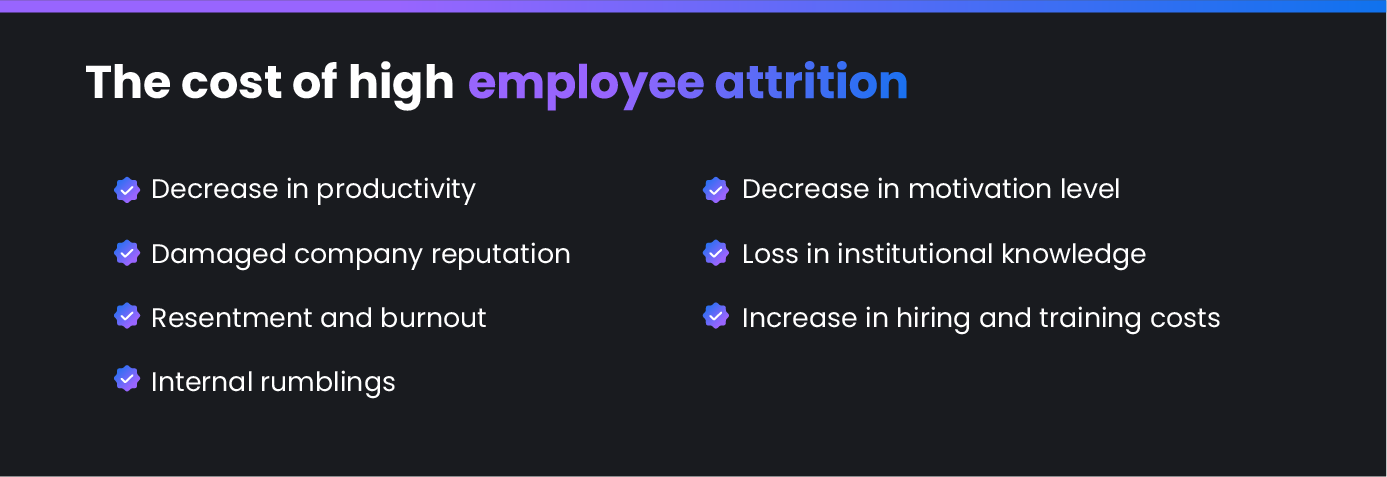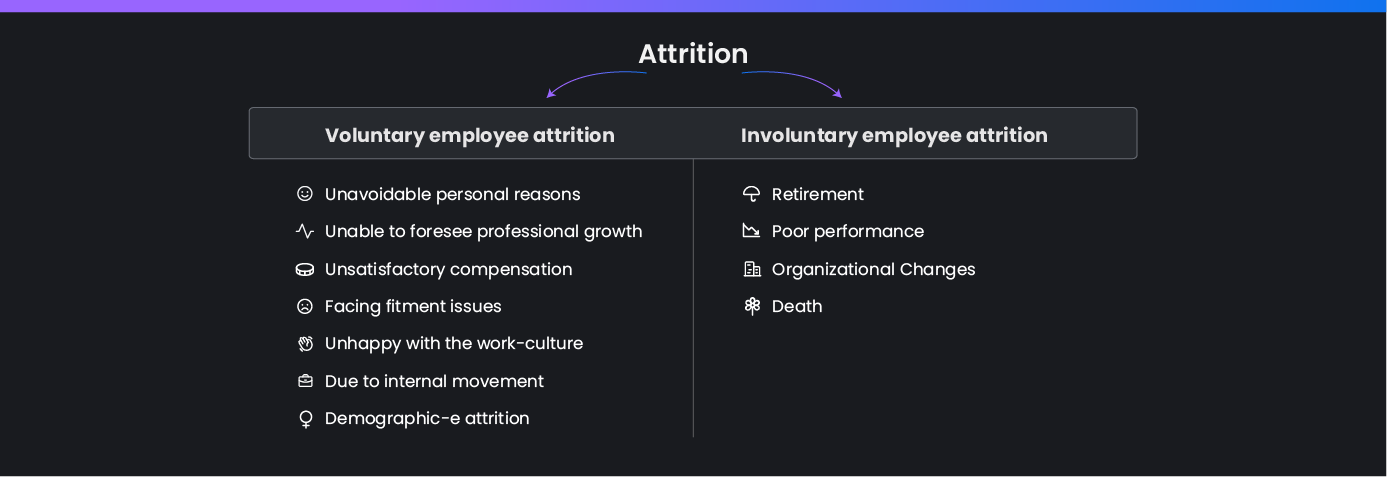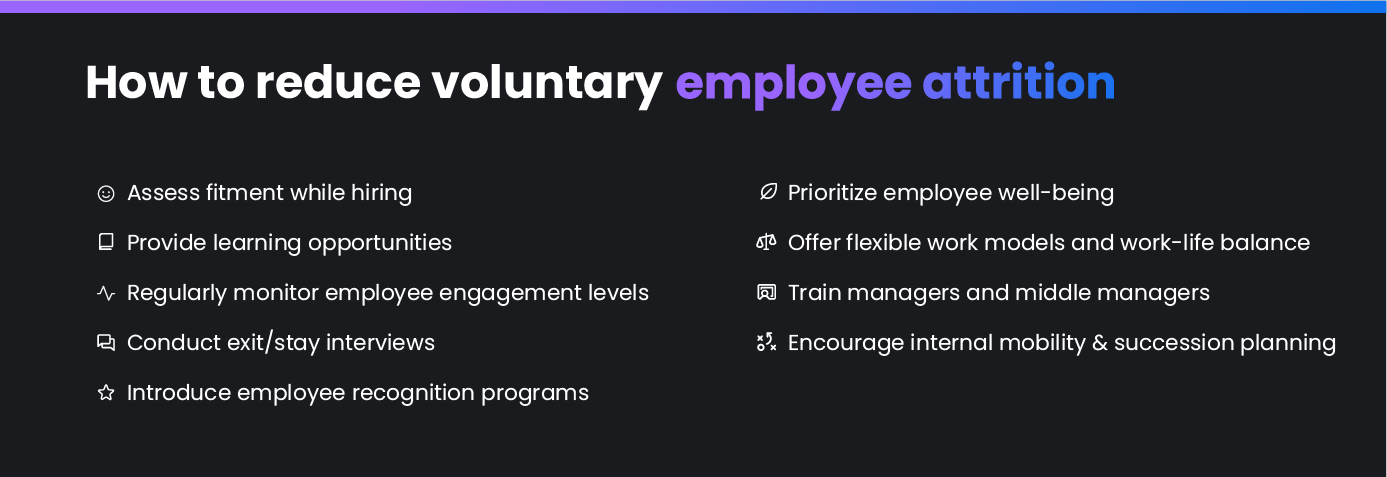What is employee attrition?
Employee attrition is defined as the voluntary or involuntary departure of employees from an organization. Voluntary attrition occurs when employees choose to leave for reasons such as pursuing better career opportunities, higher pay, dissatisfaction with the organizational culture, personal illness, furthering their education, or relocation. In contrast, involuntary attrition involves employees leaving due to factors beyond their control, such as retirement, death, or termination.

Employee attrition is often a matter of concern when HRs are not able to hire as fast as the rate at which employees are leaving.
For example, 60% of your organization’s staff is currently performing remotely or in a hybrid work setting . However, the organization states that full-time office operations will return within the next three months and that participation will be mandatory. Since this is the case, the turnover rate among remote workers increases rapidly within three months.
What is the employee attrition rate?
Employee attrition rate means the rate at which employees leave an organization.
No matter the reason for attrition, a high attrition rate suggests that an organization is losing workforce power. When an employee leaves and the vacancy they create remains unfilled, or the position is eliminated, this indicates the employee attrition rate.
It is not uncommon now for candidates to ask about an organization’s employee attrition rate during interviews and check Glassdoor reviews and Linkedin updates. When a company has a history of high attrition rates, recruiters often struggle to recruit new employees.
How to measure employee attrition rate?

Here is a simple formula to calculate employee attrition rate:
Annual Attrition Rate = (Number Of Leavers/ Number Of Employees) x 100
For instance:
Annual Attrition Rate = (50/500) x 100
Annual Attrition Rate = (0.1) x 100
Annual Attrition Rate = 10%
Employee attrition rate is measured by taking the sum of employee exits in a specified time frame divided by the total number of employees in that time period, multiplied by 100.
This employee attrition rate formula can be used to calculate a monthly turnover rate, a year-to-date turnover rate, an annual turnover rate, or any time period you want to measure.
Knowing your organization’s employee attrition rate is highly important to better manage talent and take countermeasures to try and retain your best employees. The rate may be used to investigate the reasons for employee attrition and implement solutions.
Till now you must be clear that a high employee attrition rate is detrimental to the health of an organization. But now, let’s dive into what kind of impact a high attrition rate has and why it is important to measure employee attrition.
The cost of high employee attrition: Why does employee attrition rate matter?

There’s a solid reason why businesses invest millions of bucks and countless hours on retention strategies. A high rate of employee attrition is often an indication that something is wrong. One reason is the high expense of replacing a team member. It takes a lot of work and money to find, hire, and train an employee. By measuring attrition rates, a company may pinpoint problems that are causing voluntary attrition.
If not measured on time, high employee attrition costs the following:
- A significant decrease in productivity due to lack of morale.
- Damage to your company’s reputation, which makes it harder to attract top talent.
- Resentment and burnout, as workers scramble to make up for the work of the employees who have left.
- Internal rumblings, as current employees wonder if they should jump ship too, can negatively impact productivity as your current workers start job-searching.
- Decrease in motivation level, especially when an employee leaves involuntarily.
- Loss in institutional knowledge, in case a skilled employee decides to leave.
- Increase in hiring and training costs. A study by the Society for Human Resource Management states that employers will need to spend the equivalent of six to nine months of an employee’s salary in order to find and train their replacement.
The recent trends in employee attrition:
In recent years, employee attrition has been influenced by several notable trends that have reshaped the dynamics of the workforce. From the impact of the COVID-19 pandemic on remote work preferences to the emerging priorities of new generations entering the job market, organizations have faced unique challenges in retaining their talent. Additionally, a shortage of specialized skills and an increasing focus on work-life balance have further contributed to fluctuating attrition rates. Understanding and adapting to these trends have become crucial for companies aiming to reduce attrition and maintain a stable and engaged workforce. Let’s explore some of these recent trends and their implications for businesses in greater detail.
Remote work and the pandemic:
The COVID-19 pandemic forced many companies to adopt remote work policies. While this provided flexibility for employees, it also led to an increase in attrition as some individuals sought opportunities with more permanent remote work options.
Skills shortage:
Certain industries faced skill shortages, making it challenging for companies to retain employees with specialized skills. In such cases, employees often received competitive offers from other companies, leading to increased attrition.
Job market rebound:
As the economy rebounded from the pandemic’s impact, job opportunities increased. Employees were more willing to explore new job options, contributing to higher attrition rates.
Employee burnout:
The pandemic’s prolonged stress and uncertain work conditions led to higher levels of employee burnout. This, in turn, drove some employees to seek alternative job opportunities to escape high levels of stress.
Generational changes:
The workforce has been experiencing generational shifts, with millennials and Gen Z employees becoming a larger part of the workforce. These generations often have different career expectations and may be more open to exploring new opportunities.
Work-life balance:
Employees increasingly value work-life balance and may leave companies that do not offer flexible work arrangements or sufficient support for their personal well-being.
What are the different types of employee attrition and the factors affecting them?

In the business world, voluntary and involuntary employee attrition both happen on a frequent basis. Here we will take a look at what these two types of employee attrition mean and how they affect an organization.
Voluntary employee attrition
Voluntary attrition is defined as when an employee decides to leave the organization due to their own personal or professional reasons. Not all voluntary reasons indicate that there is a problem with the company, however, there are some reasons that might indicate the budding of some internal issues.
Let’s take a look at them:
Unavoidable personal reasons
Sometimes workers have to leave their jobs owing to personal issues that have nothing to do with their employers. These departures might be due to a variety of factors, such as a desire to start a new chapter in life, a change in living arrangements, the arrival of a new child, the need to care for an ailing family member, the pursuit of further education, or the launch of a new enterprise. The employee may require rest, or they may be looking to switch careers. In certain cases, continuing to work while also dealing with such issues is impossible.
Unable to foresee professional growth
The fast-paced job industry demands employees to switch to a one-man army whenever the need arises. Employees with an extra skill set always outshine on a recruiter’s list. But, what about your existing workforce and their professional development? Humans have an insatiable need for new experiences and the constant pursuit of personal and professional growth. If employees do not see themselves advancing in their chosen areas and are stuck in a dead-end job, they will lose their productivity and motivation to work.
Unsatisfactory compensation
Workers are concerned about rising prices and the possibility of a worldwide economic downturn, so they are looking for ways to protect themselves financially. Employees are looking for more pay since they have less options for increasing their career chances. Job and personal fulfillment are both impacted immediately. Employees are leaving the company due to the lack of competitive remuneration packages. It is one of the leading factors affecting employee attrition.
Facing fitment issues
When a person’s skills and interests are mismatched with the requirements of their employment, this is known as a bad fit. Employees that are a good match for their jobs are more likely to be loyal, effective team members. However, workers who are mismatched with their jobs are less effective, dissatisfied, and prone to leave. Disengagement occurs in the workplace when workers do not feel they are a good match for the job. In reality, dissatisfaction with one’s employment is a leading cause of disengagement. The issue impacts both new hires and experienced employees, therefore causing employees to leave the organization.
Unhappy with the work-culture
Providing a high salary in the short term is not the only way to keep a worker interested in their career. Stress, irritation, and decreased productivity are some of the main reasons for employee attrition. Equally important to their annual salary is a work environment that promotes wellness and a sense of community among employees. Additionally, in today’s competitive job market, candidates are not afraid to inquire about a work-life balance, telecommuting options, and other benefits at the first interview stage. If they don’t think the company’s culture will encourage them to flourish, they may choose other opportunities or even wait till the right one comes along.
Management firm McKinsey & Company recently surveyed a number of employees, and 36% of those employees who had quit in the past six months didn’t have a new job lined up.
Due to internal movement
Intenal attrition happens when an employee decides to leave their department and move to another department within the organization. A high rate of attrition in one particular department can be a cause of concern that should be looked into immediately. In such cases, following questions must be put into perspective, is the manager adequately skilled?, is there a bitter team environment?, is the team continuously failing to meet their targets? Your organization’s HR department can look into this and come up with recommendations. However, in other instances, this may really be a good thing for the business! As a result, it is possible that people are being redirected to more lucrative roles. Long-term, it may also result in a better match between employees and their jobs.
Demographic-e attrition
Many females have to resign due to cultural and environmental issues. Women are expected to juggle a lot of responsibilities at work and at home, often without help from friends, family, or coworkers. Marriage, reliance on family, health problems, child care, inflexible working hours, unexpected transfers, and other factors all play a role in the attrition of women from the private business sector. The presence of these obstacles makes it difficult for women to advance in the workplace. Managers do strive to issue rules that will reduce attrition, but these policies often fail to have the desired effect because they do not address the underlying problems that women in the workforce confront, and/or because of inefficient implementation.
Involuntary employee attrition
Involuntary attrition occurs when the business dismisses employees or they retire from the job. This form of attrition is typically initiated by the employer rather than the employees themselves. Reasons for involuntary attrition may include layoffs during organizational restructuring, downsizing efforts to cut costs, or termination due to poor performance or disciplinary actions. It stands in contrast to voluntary attrition, where employees willingly leave the company to pursue other opportunities or due to personal reasons.
-
Retirement
The final stage of an employee’s life cycle is retirement. Eventually, the curtain will fall on every professional life. A worker’s retirement is inevitable, even if they spend their whole working life at the same organization. Businesses need to be alert when employees approach retirement age, especially if significant numbers of employees are expected to retire simultaneously. However, if managers are unprepared, even one employee’s retirement can cause chaos in the workplace. Long before the retirement celebration, it’s necessary to start looking for successors and getting them up to speed. If not, businesses and government agencies risk losing the wisdom and experience of their veteran employees.
-
Poor performance
Most involuntary terminations are probably due to poor performance. You may not be able to control every one of the factors that lead to poor performance. In spite of the fact that severing ties with a low-performing employee often results in an improvement in morale and increased productivity for the team’s remaining members, exit surveys can reveal some startling truths about what went wrong.
-
Organizational Changes
When times are tough for a company, it may try to save expenses by laying off employees, reorganizing the workforce, or some combination of these strategies. Jobs may also be transferred from one organization to another as a result of outsourcing.
-
Death
When one of your workers loses a loved one, it could be an extremely difficult moment for them. They may need more time away from work to deal with their loss and go back to being themselves, even after taking a few weeks off. And in certain cases, a break from the workplace may appear to be the only reasonable choice. In such delicate situations, businesses who aren’t concerned about their employees’ mental health might lose a valuable employee forever.
Regrettable employee attrition
Regrettable employee attrition occurs when a company loses valuable, high-performing employees it would prefer to keep. These individuals possess critical skills and potential for growth. To mitigate this loss, organizations can implement several strategies. Conducting stay interviews to understand employees’ needs and aspirations helps address potential issues proactively. Offering competitive compensation and benefits ensures employees feel rewarded and valued for their contributions.
Additionally, providing growth opportunities through training and career development programs promotes advancement within the company. Cultivating a positive work culture that values employee well-being and fosters open communication fosters loyalty and engagement. Recognizing and rewarding performance, offering work-life balance, and promptly addressing workplace concerns all contribute to reducing regrettable attrition, enabling companies to retain their top talent and enhance overall productivity and success.
Workforce attrition
Workforce attrition refers to the natural process of employees leaving a company over time, either voluntarily or involuntarily. It can occur due to various reasons, such as better job opportunities, retirement, layoffs, or dissatisfaction with the work environment. To reduce workforce attrition, companies can implement several strategies.
Firstly, fostering a positive and inclusive work culture can increase employee satisfaction and loyalty. Offering competitive compensation, benefits, and opportunities for growth and development can incentivize employees to stay. Conducting regular performance evaluations and providing constructive feedback helps address potential issues and improve job satisfaction. Additionally, creating a work-life balance through flexible arrangements and supporting employee well-being can contribute to reducing attrition and retaining valuable talent.
What are the best practices to prevent employee attrition?

Employee attrition is a problem that, like any other, has more than one solution. The rate of turnover can be lowered by adopting a few basic but impactful strategies.
Here are a few recommendations for reducing employee attrition:
-
Asses fitment while hiring
Being smart throughout the hiring and onboarding phases help guarantee that new employees are a good cultural fit, receive the necessary training, and know what to anticipate from their new position. According to research by Jobvite, just about half of employees feel that job titles accurately represent real duties, and over a third of workers have quit within the first 90 days of a new job because the work wasn’t what they were expecting.
-
Provide learning opportunities
To show that you value your employees, nothing speaks louder than giving them the chance to learn new skills and advance in their careers. Millennials and members of the Generation Z who have never known a world without the internet have a huge thirst to upskill. Building a mentoring program that connects managers with employees for educational purposes is a great way to make employees feel like they have a stake in the company’s success.
-
Regularly monitor employee engagement levels
The level of employee engagement should be closely monitored at all times since a highly engaged workforce has a far lower attrition rate. The use of surveys and focus groups to gauge employee engagement is a good first step, but only if the results are analyzed and implemented. Companies might benefit from investing in AI-backed employee engagement software that provides detailed reports on employee sentiments, company mood scores, and so on. It can indicate patterns and provide insights that can help in building a future-proof employee engagement plan.
-
Conduct exit/stay interviews
While it is always unfortunate to see an employee go, we wish them the best in their future endeavors. However, it is important for businesses to learn the reasons for a worker’s departure, find out where they’re heading, and hear their final remarks through an exit program. Exit interviews are a great way to ensure that departing workers have a favorable opinion of both your firm and their time spent there.
-
Introduce employee recognition programs
All employees should receive encouragement and mentors to follow if they are to perform at their highest potential. Programs that show appreciation for employees’ efforts typically don’t cost much, if anything at all, but can have a significant impact. The best forms of appreciation are those that are both heartfelt and sincere, whether they take the form of a modest birthday party or a monetary incentive for a job well done. Reviewing an employee’s performance should be an opportunity to highlight their achievements and express gratitude for their efforts.
-
Prioritize employee well-being
Employee wellness initiatives should not be discounted. Companies who fail to acknowledge that their employees put in long hours under often difficult situations are generally the first to lose their employees. Investing in wellness services, like providing employees with access to a gym, supplemental healthcare subscriptions, and stress-relieving practices like chair massage and yoga sessions, are a hidden hero of effective employee engagement.
-
Offer flexible work models and work-life balance
Many employees experience difficulties striking a work-life balance, which can lead to burnout and a subsequent search for a new position. This pattern is most prominent among employees who are older, who are married, and who have children. Employers who encourage remote and flexible work arrangements in an effort to assist employees to find a better work-life balance, in turn, retain more of their staff.
-
Train managers and middle managers
Effective communication, team motivation, and management of people are all qualities that may be greatly enhanced via leadership development training. Therefore, it’s true that workers who report directly to managers who have received training in the art of motivating and inspiring their teams would have more success and happiness in their work, which in turn may lead to higher employment longevity. Investing in future leaders also helps with employee retention by showing employees that there are possibilities for advancement within the company. Remember, leaders drive values, values drive behavior, behavior drives culture and culture drives performance.
-
Encourage internal mobility & succession planning
Internal mobility initiatives enable individuals to advance their careers and continue their education within an organization rather than looking elsewhere for opportunities to grow and develop their skills. Additionally, succession planning lessens the likelihood of losing important employees by training and educating them so that they can assume leadership roles effectively. In order to replace critical positions and close skill shortages, modern businesses must take proactive steps along the succession planning route.
-
Recognize and reward performance:
Recognizing and rewarding employee performance is a powerful way to boost morale and increase employee engagement. Regularly acknowledging and appreciating employees’ efforts, achievements, and contributions can create a positive and motivating work environment.
Recognition can take various forms, such as verbal praise, written commendations, public appreciation in team meetings or company-wide communications, or awards and incentives. Rewards can include bonuses, promotions, extra time off, or other tangible incentives. By making recognition and rewards a consistent part of the organizational culture, employees are more likely to feel valued and motivated to stay with the company.
-
Encourage open communication:
Open communication is the foundation of a healthy and engaged workplace. When employees feel comfortable expressing their thoughts, concerns, and ideas, it fosters a sense of trust and transparency between employees and management.
Organizations should promote open communication channels, such as regular one-on-one meetings between managers and team members, anonymous feedback systems, suggestion boxes, or employee surveys. Actively listening to employee feedback and addressing their concerns demonstrates that the organization values their opinions and is willing to make improvements based on their input.
Encouraging open communication also involves being receptive to constructive criticism and being willing to involve employees in decision-making processes. This inclusion helps employees feel more invested in the company’s direction and fosters a sense of ownership and loyalty.
-
Offer competitive compensation and benefits:
Competitive compensation is the most important for attracting and retaining top talent. Employees want to feel that their work is adequately rewarded and that their efforts are recognized and valued. Organizations should conduct regular salary benchmarking to ensure that their pay scales are in line with industry standards and reflect the employees’ skills and contributions.
In addition to competitive pay, offering attractive benefits packages can significantly impact employee retention. These benefits may include health insurance, retirement plans, paid time off, flexible work arrangements, childcare support, and more. A comprehensive benefits package not only improves employee satisfaction but also demonstrates that the organization cares about its employees’ well-being.
What employee attrition is not?
Employee attrition vs. employee turnover
| Employee Attrition | Employee Turnover | |
| Definition | The gradual loss of employees over time, typically due to retirement or resignations. | The replacement of one employee with a new hire. |
| Causes | Employee dissatisfaction, lack of career advancement opportunities, poor work-life balance, low pay, poor management. | Better job opportunities elsewhere, personal or family reasons, poor fit with company culture or values. |
| Impact on organization | Can lead to reduced productivity, loss of institutional knowledge, and increased workload for remaining employees. | Can disrupt workflow and impact team dynamics, lead to increased training and onboarding costs for new hires. |
| Measures to prevent/reduce | Offering competitive compensation and benefits packages, providing opportunities for career development and advancement, promoting work-life balance, improving management practices. | Improving company culture and values, providing opportunities for career development and advancement, offering competitive compensation and benefits packages. |
-
Employee attrition vs employee layoff
| Employee Attrition | Employee Layoffs | |
| Definition | The gradual loss of employees over time, typically due to retirement or resignations. | The termination of employment for a group of employees due to financial or operational reasons. |
| Causes | Employee dissatisfaction, lack of career advancement opportunities, poor work-life balance, low pay, poor management. | Economic downturn, restructuring, cost-cutting measures, business closure or downsizing. |
| Impact on organization | Can lead to reduced productivity, loss of institutional knowledge, and increased workload for remaining employees. | Can lead to reduced productivity, negative public perception, and increased workload for remaining employees. |
| Measures to prevent/reduce | Offering competitive compensation and benefits packages, providing opportunities for career development and advancement, promoting work-life balance, improving management practices. | Implementing effective cost-cutting measures, improving efficiency, diversifying revenue streams. |
-
Employee attrition vs employee retention
| Employee Attrition | Employee Retention | |
| Definition | The gradual loss of employees over time, typically due to retirement or resignations. | The ability of an organization to keep its employees. |
| Causes | Employee dissatisfaction, lack of career advancement opportunities, poor work-life balance, low pay, poor management. | Competitive compensation and benefits packages, opportunities for career development and advancement, positive work environment and culture, effective management practices. |
| Impact on organization | Can lead to reduced productivity, loss of institutional knowledge, and increased workload for remaining employees. | Can lead to improved productivity, lower training and onboarding costs, and a positive public image. |
| Measures to improve | Offering competitive compensation and benefits packages, providing opportunities for career development and advancement, promoting work-life balance, improving management practices. | Offering competitive compensation and benefits packages, providing opportunities for career development and advancement, promoting a positive work environment and culture, improving management practices. |
What Is A ‘High’ Employee Attrition Rate?
Calling a certain employee turnover rate good or poor would be an oversimplification. What defines a healthy attrition rate is primarily based on your sector as well as your individual business style.
Attrition rates measure how long employees stay with your organization rather than how often they leave. The rate of employee turnover will also differ depending on the scale of your business. However, if your annual turnover rate is more than 20%, your team should investigate the cause.
In addition, if more than 15% of your new hires leave during the first six months of work, it could be time to reevaluate your onboarding procedures (simply to make sure everyone is getting up to speed quickly).

Can Attrition Be Beneficial?
Contrary to popular belief, attrition isn’t necessarily disastrous. Employee attrition within a certain limit is often beneficial to businesses for a number of reasons.
- When low-performing workers depart, it frees up resources and makes place for better performers.
- Attrition can pave the way for diversity in monolithic workplaces (such as IT corporations that employ a disproportionately large number of men).
- Those who aren’t a good match for the position are weeded out, indicating that the hiring decision was flawed.
- If the same people with the same ideas aren’t leading the firm for decades, it helps foster a more innovative and adaptable staff.
- It is necessary during periods of structural change, such as when a company is changing its focus or when resources are few.
When assessing the reasons for employee turnover, keep these in mind. The cost of attrition to your company will vary depending on the kind of talent lost and the circumstances surrounding the departure.
Addressing Employee Attrition with Leena AI
Today’s businesses must learn to effectively communicate and interact with their remote, hybrid, and on-site workforces, or risk falling behind the competition. A reliable and quick network for communicating with all employees is necessary to promote employee engagement and a culture of trust and collaboration in the workplace. This is where Leena AI can aid in the building of strong teams, the acceleration of overall productivity, and the reduction of unnecessary turnover.
Leena AI’s generative AI-powered employee engagement software enables you to establish a culture that stands out from the competition by listening to your staff, responding to their feedback in real time with AI Action Planning, and preventing high-quality employees from leaving.

- AI and machine learning technologies help businesses identify employees in danger of leaving and implement early intervention to lower turnover rates.
- Leena AI empowers your employees by providing them the opportunity to voice their concerns and opinions via automated conversations.
- Equips HRs with predictive analytics, intelligent insights and real-time action planning based on automated analysis of employee feedback.
- Provides a single dashboard for leaders to track and improve employee engagement metrics, predict employee attrition, sentiment analysis and build a great organizational culture.
Leena AI conducts in-depth surveys of employees and gets insight into their attitudes and levels of motivation. Our engagement dashboard generates intelligent, actionable analytics that reveals which workers are disengaged, dissatisfied, and ready to go.
Through surveys, evaluations, and other types of input, the AI-powered virtual assistant may gain a sense of the company culture and employee satisfaction levels. These surveys provide valuable information for human resources departments looking to improve employee engagement and retention by identifying and addressing the root causes of high turnover.
To Sum Up
Reduced attrition saves money in two ways: first, by avoiding the time and effort required for finding and onboarding new employees. Second, by enhancing company culture and reducing attrition.
Effective employee experience and engagement strategies help businesses retain their most valuable people and boost employee engagement. In order to increase retention and return on investment (ROI), you need to take the first step by investing in intelligent AI powered software like Leena AI which has all the tools, and data you need to put your plans into action.
Meet Leena AI
Schedule a demo todayFrequently Asked Questions
What does employee attrition mean?
Employee attrition occurs when the size of your workforce diminishes over time due to unavoidable factors such as employee resignation for personal or professional reasons. Employees are leaving the workforce faster than they are hired, and it is often outside the employer’s control. Understanding the reasons behind attrition, such as limited career growth opportunities, work-life balance issues, inadequate compensation, and organizational culture problems, is essential for employers to develop effective strategies to retain talent and mitigate the negative impacts on the business. By investing in talent acquisition, training, competitive compensation, work-life balance initiatives, and employee engagement, companies can create a positive work environment that fosters loyalty and reduces the occurrences of employee attrition.
What causes employee attrition?
There are numerous reasons for attrition, including the lack of professional growth, a hostile work environment, or declining confidence in the company’s market value. Weak leadership is another factor that often drives attrition among employees. Therefore, organizations must prioritize leadership development to ensure that their leaders possess the skills and qualities necessary to nurture a positive and engaging work environment, ultimately reducing employee attrition and cultivating long-term success.
How do you stop employee attrition?
Employee turnover is a problem that, like any other, has more than one solution. The rate of turnover can be lowered by adopting a basic strategy. Here are a few strategies for reducing staff turnover. Tips for minimizing the financial impact of employee turnover.
- Assess fitment while hiring
- Learning opportunities
- Regularly monitor employee engagement/satisfaction
- Competitive pay
- Exit/stay interviews
- Employee recognition programs
- Relook at employee benefits
- Focus on employee well being
- Flexible work models and work life balance
- Succession planning, internal promotions, internal mobility
- Train managers and middle managers
Why does employee attrition matter?
The productivity of your business may suffer as a result of employee turnover. That’s why tracking your current rate of employee exits is crucial. The hiring price is the first place to see a change. After all, estimates for the cost of replacing a highly qualified worker range from 120 to 200 percent of the employee’s yearly compensation. Therefore, proactive tracking and analysis of employee attrition rates are essential for businesses to identify underlying issues, implement effective retention strategies, and maintain a stable and thriving workforce.
How to calculate employee attrition rate?
Conduct a headcount to know how many employees you started with at the beginning of the year. Keep track of how many people leave throughout the year due to voluntary and involuntary reasons. Keep track of the employees you hire across the year, and conduct a final headcount at year-end. Now, calculate the average number of employees for that year. Finally, calculate the number of employees who left as a percentage of the average number of employees. This will give you the attrition rate.
What is a good employee attrition rate?
A good employee attrition rate varies depending on the industry and company size. In general, a rate below 10% is considered favorable, indicating a stable workforce and positive work environment. However, some industries with high turnover rates, such as retail or hospitality, may have different benchmarks. Regardless, it’s crucial for organizations to understand their specific context and work towards maintaining a healthy balance between retaining valuable employees and allowing for healthy turnover to facilitate growth and innovation.
What causes good employees to leave?
Some of the most common explanations for why employees decide to quit are as follows:
- Lack of respect or trust
- Low pay
- Poor company culture
- Feeling overworked and underappreciated
- Bad manager
- No growth opportunities
- Disconnect with company values
- Team issues
- Poor leadership
- No work-life balance
What are the consequences of attrition?
A high attrition rate can make you deal with some of the following challenges:
- A significant decrease in productivity
- Damage to your company’s reputation, which makes it harder to attract top talent
- Resentment and burnout, as workers scramble to make up the work of the person they’ve lost
- Internal rumblings, as current employees wonder if they should jump ship too, can negatively impact productivity as your current workers start job-searching
- Causes a lack of motivation and low morale, especially when an employee leaves involuntarily
- loss in institutional knowledge
- increase in hiring and training costs
How does employee disengagement impact attrition?
Disengaged employees affect levels of engagement for all members of the team, which may lead to additional employees resigning. To make matters worse, all it takes is one disgruntled worker to start circulating rumors about your company’s terrible work environment and culture to make recruitment a nightmare. As disengagement spreads within the team, it creates a negative ripple effect, potentially affecting overall team morale and productivity. Consequently, retaining top talent becomes increasingly challenging, and the organization may struggle to attract skilled candidates due to the tarnished employer reputation resulting from negative word-of-mouth.
Is employee attrition always bad?
Companies may experience difficulties when employees leave since doing so may result in the loss of skilled workers. However, there are times when this is beneficial. When a company loses employees, it may be forced to examine its practices in order to determine the root causes of the problem. Companies can save money on payroll by not having to replace workers who voluntarily quit. Over time, it may result in the recruitment of new staff members who bring new perspectives and vigor to the company.
What employee attrition rate says about your business?
In order to go forward successfully, each company relies heavily on the efforts of its personnel. Due to the significant expenses associated with replacing departing workers, a company cannot survive if its staff turnover rate is excessive. In addition, a high rate of staff turnover increases the likelihood that the company would receive poor ratings from its workforce. Moreover, a high staff turnover rate can lead to a loss of institutional knowledge, as experienced employees take valuable insights and skills with them when they leave. This loss can result in a decline in overall organizational efficiency and may hinder the company’s ability to innovate and adapt to market changes effectively.
How to reduce employee attrition?
Attrition has obvious negative effects, including a smaller staff, a loss of product/domain expertise, and potential harm to the company’s reputation as an employer. And this is why businesses need to:
- Determine if a candidate is a good match for the position and company culture throughout the recruiting process. Provide employees with chances for continued education and advancement.
- Inquire frequently about how things are doing with your staff.
- Maintain a salary that is competitive with that of similar businesses.
- In order to identify patterns of employee turnover, follow-up interviews should be conducted after employees have left the company.






